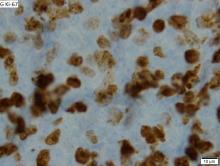For older, less fit patients with mantle cell lymphoma (MCL) who may not be able to withstand the rigors of autologous stem cell transplants (ASCT), induction chemotherapy followed by radioimmunotherapy (RIT) consolidation with ibritumomab tiuxetan (Zevalin) was associated with good response rates and promising progression-free and overall survival rates, according to results of a phase 2 prospective study.
RIT consolidation improved the complete response rate following first-line therapy from 41% to 91%, reported Wojciech Jurczak, MD, PhD, from the department of hematology at the Uniwersytet Jagiellonski in Krakow, Poland, and colleagues.
In the patients who received RIT following first-line induction, median progression-free survival was 3.3 years, and median overall survival was 6.5 years.
“The achieved responses are durable. Although, several novel agents and targeted therapies alone or in combination are currently being studied and developed in both the upfront and relapsed settings, RIT constitutes a valid and underused option especially in the first-line setting,” they wrote in a study published in Leukemia & Lymphoma.
The investigators enrolled 46 patients with clinical stage III to IV MCL who were either ineligible for, or unwilling to undergo, ASCT. The cohort included 34 patients with newly diagnosed advanced MCL and 12 with chemo-sensitive MCL in first relapse.
Patients were assigned to induction with six cycles of chemotherapy, with or without rituximab. Patients then underwent consolidation with RIT if they had confirmed reductions of the maximal lymph node diameter below 3 cm, their longest spleen measurement was below 15 cm, and bone marrow infiltration was less than 20%.
The chemotherapy regimens included either CVP (cyclophosphamide, vincristine and prednisone), CHOP (cyclophosphamide, doxorubicin, vincristine, and prednisone), FC (fludarabine and cyclophosphamide), or FCM (FC plus mitoxantrone). Additionally, 27 of the 46 patients received rituximab, which was not considered the standard of care in Poland when the study began in 2005 and was delivered based on availability.
Of the 34 patients who received first-line chemotherapy, 20 received FC or FCM (with or without rituximab), and 14 received CHOP or CVP (with or without rituximab). In this group, 14 patients (41%) had a complete response, and 20 (95%) had a partial response. Of the 12 patients treated after first relapse, two (17%) had a complete response and 10 (83%) had partial response after induction.
RIT consolidation was performed 3-5 weeks after the last chemotherapy cycle. Patients with cytopenias after chemotherapy could wait an additional 3 weeks, during which they would receive a bridging dose of rituximab at the standard 375 mg/m2 dose. The patients received two doses of rituximab 250 mg/m2 administered 7 days then 24 hours prior to intravenous injection of 90Y-labeled ibritumomab tiuxetan. The radiation doses delivered were 0.4 mCi/kg for patients with normal platelet counts and 0.3 mCi/kg for those with platelet counts from 100,000 to 150,000 cells/mm3. The maximum dose was 32.0 mCi.
The longest follow-up was out to slightly more than 8 years.
For the patients who received RIT after first-line induction, the complete response rate was 91%, and the partial response rate was 9%, compared with 41% complete response and 59% partial response after induction. In this group, the median progression-free survival was 3.3 years, and the median overall survival was 6.5 years.
For the patients who received RIT consolidation after first relapse and second chemotherapy regimen, the complete response rate was 75% and the partial response rate was 25%, compared with 17% and 83% at the end of second induction therapy. In this group, the median progression-free survival was 1.8 years (P less than .05, compared with patients treated after first-line responses), and the median overall survival was 2.2 years (P less than .05).
At 8 years of follow-up, 30% of patients who received RIT consolidation following first-line therapy were alive.
Adverse events included cytopenias in the majority of patients (77%), which were grade 1 or 2 in severity in 43% and grade 3 or 4 in 34%. Grade 3 or 4 thrombocytopenia and leukopenia occurred more frequently in patients treated with fludarabine-based regimens, and the thrombocytopenias in these patients lasted longer and required more platelet transfusions than those in CHOP- or CVP-treated patients. Two patients who underwent RIT following FCM induction died from prolonged thrombocytopenia, resulting in hemorrhagic strokes.
Among all patients, 22 patients developed infections following RIT consolidation. Five patients, all of whom had received fludarabine, required hospitalization for the treatment of the infections. There were no infection-related deaths, however.
Five patients developed the myelodysplastic syndrome, with a median onset time of 26 months. Of these patients, four had received fludarabine, and one had undergone a prior ASCT.
The trial was sponsored by Schering AG. Dr. Jurczak reported speakers bureau participation and research funding from multiple companies, not including Schering AG.
SOURCE: Jurczak W et al. Leuk Lymphoma. 2019 Apr 9. doi: 10.1080/10428194.2019.1602261.


